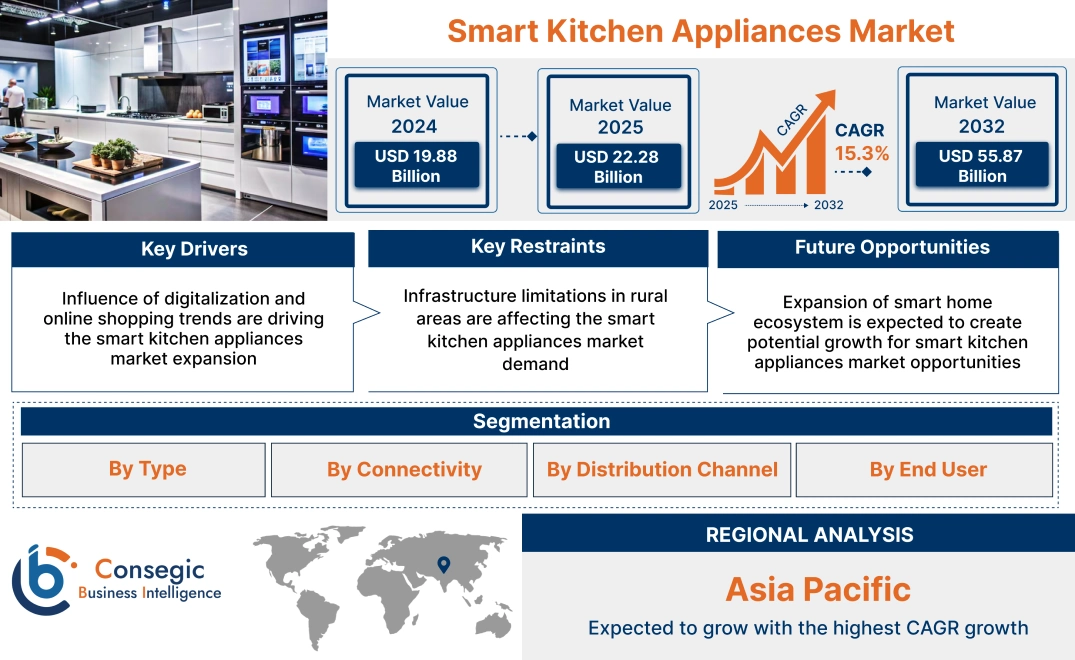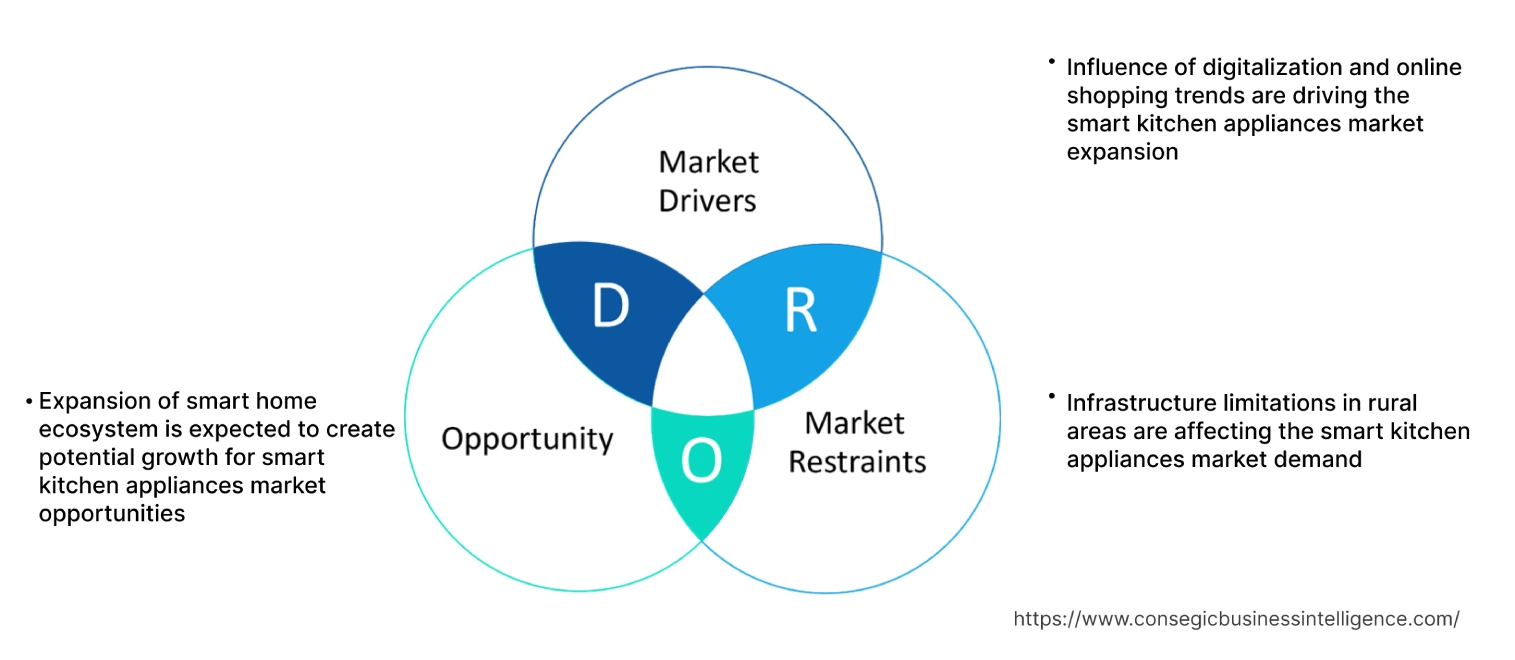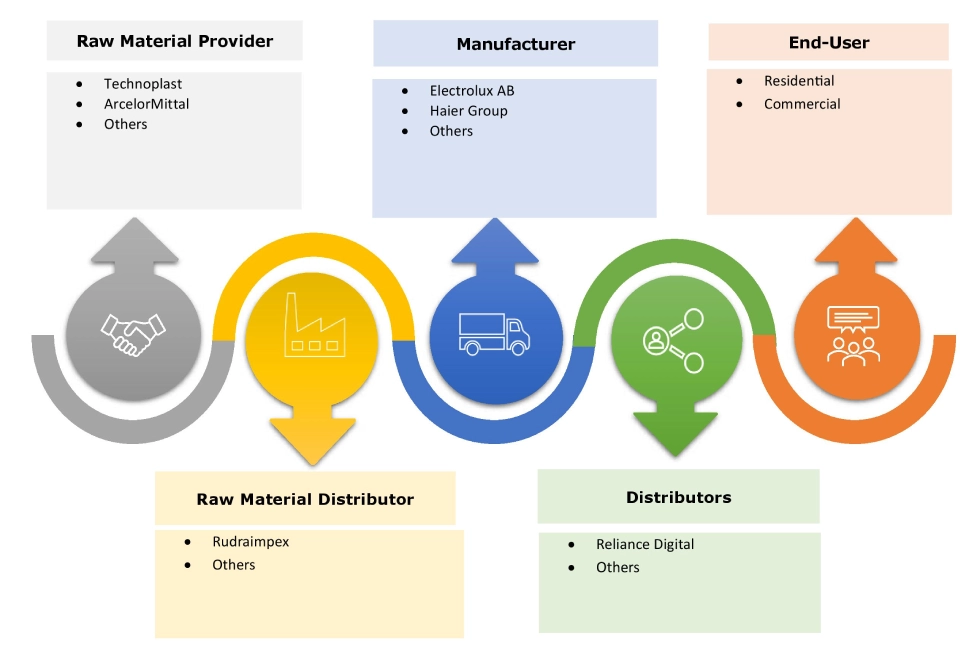- Summary
- Table Of Content
- Methodology
Smart Kitchen Appliances Market Size:
Smart Kitchen Appliances Market Size is estimated to reach over USD 55.87 Billion by 2032 from a value of USD 19.88 Billion in 2024 and is projected to grow by USD 22.28 Billion in 2025, growing at a CAGR of 15.3% from 2025 to 2032.
Smart Kitchen Appliances Market Scope & Overview:
Smart kitchen appliances are devices equipped with internet connectivity and advanced automation technologies, designed to enhance kitchen tasks through features like remote control, recipe suggestions, and energy efficiency. As consumers embrace connected lifestyles and seek seamless integration of smart devices into their homes, the demand for smart kitchen appliances that offer intuitive interfaces, personalized experiences, and interoperability with other smart home devices continues to rise.
Key Drivers:
Influence of digitalization and online shopping trends are driving the smart kitchen appliances market expansion
The influence of digitalization and online shopping has emerged as a significant driver in the global market, while reshaping consumer behaviors and preferences in the purchase and use of kitchen appliances. As digital technologies continue to permeate various aspects of daily life, consumers increasingly seek interconnected solutions that offer convenience, efficiency, and connectivity, extending to the range of kitchen appliances. Digitalization has transformed the way consumers research, evaluate, and purchase kitchen appliances, with online channels playing a pivotal role in shopping journeys. The proliferation of e-commerce platforms, manufacturer websites, and third-party online retailers provides consumers with unparalleled access to a vast array of smart kitchen appliances, allowing them to compare features, read reviews, and make informed purchase decisions from the comfort of their homes.
- For instance, in March 2025, Amazon offered discounts up to 84% on home appliances, which include ice makers, water purifiers, fans, and juicers. The sale offers deals on products from global brands including kitchen appliances.
Therefore, according to the smart kitchen appliances market analysis, the influence of digitalization and online shopping are driving the smart kitchen appliances market size.
Key Restraints:
Infrastructure limitations in rural areas are affecting the smart kitchen appliances market demand
Infrastructure limitations in rural areas represent a significant restraint in the global market, presenting challenges for the widespread adoption and effective utilization of connected kitchen technologies in rural communities. Rural regions often face inadequate infrastructure in terms of internet connectivity, electricity supply, and telecommunications networks, hindering the seamless integration and functionality of smart appliances. Electricity supply may be inconsistent or unreliable in rural areas, leading to power outages and disruptions that affect the operation of smart kitchen appliances. Without access to stable electricity grids or backup power solutions, rural consumers may experience difficulties in using smart appliances effectively, particularly during periods of high demand or inclement weather conditions that strain local power infrastructure. Thus, the aforementioned factors would further impact on the smart kitchen appliances market size.
Future Opportunities :
Expansion of smart home ecosystem is expected to create potential growth for smart kitchen appliances market opportunities
The development of smart home ecosystems represents a pivotal trend in shaping the modern residential landscape, influencing how individuals manage their living spaces. These ecosystems comprise interconnected devices and systems, often facilitated by centralized hubs or smartphone applications, enabling seamless communication and control over various aspects of home life. From lighting and security to heating and entertainment, smart home ecosystems offer users superior level of convenience, comfort, and efficiency, transforming houses into intelligent, responsive living environments.
Further, IoT devices have become increasingly prevalent and affordable, while consumers are embracing the concept of interconnected smart devices to enhance their quality of life. This proliferation of IoT-enabled devices has led to the creation of robust ecosystems where different devices can communicate and collaborate to automate tasks, optimize energy usage, and improve overall home management.
- For instance, in March 2024, Haier India expanded their smart home appliances production, which includes smart refrigerators, washing machines, televisions (TVs), and air conditioners (ACs). The company also unveiled a range of smart innovations, such as smart kitchen products, water heaters, and robotic vacuum cleaners.
Thus, based on the above smart kitchen appliances market analysis, the growing smart home ecosystem is expected to drive the smart kitchen appliances market opportunities.
Smart Kitchen Appliances Market Segmental Analysis :
By Type:
Based on type, the market is segmented into refrigerator, dishwasher, wine cabinets, built-in and free-standing cookers, electric hobs, range hoods, and others.
Trends in the type:
- The segment growth is propelled by the rising need for space-saving and high-performance cooking solutions in modern kitchen designs.
- Manufacturers are responding to the consumer need by incorporating innovative features such as sensor-based controls, LED lighting, and silent operation, enhancing the functionality and appeal of built-in cooker hoods in modern kitchen designs.
- Thus, the above factors are driving the smart kitchen appliances market demand.
The refrigerator segment accounted for the largest revenue share in the year 2024.
- Wi-Fi connectivity, touchscreen displays, and AI (artificial intelligence) algorithms offer users better convenience, efficiency, and control over their refrigeration experience.
- As consumers embrace connected lifestyles and seek seamless integration of smart devices into their homes, the need for smart refrigerators that offer remote monitoring, voice control, and interoperability with other smart home devices continues to rise.
- These appliances are equipped with innovative technologies such as humidity-controlled compartments, temperature sensors, and air purification systems, which help extend the shelf life of perishable foods, preserve nutrients, and minimize food waste.
- For instance, in September 2023, LG Electronics India launched new Wi-Fi adaptable side by side fridge, which allow users to convert fridge from anywhere using LG ThinQ application.
- Thus, based on the above analysis, these factors are further driving the smart kitchen appliances market growth.
The built-in and free-standing cookers segment is anticipated to register the fastest CAGR during the forecast period.
- Multi-cookers play a pivotal role in facilitating home cooking by offering versatile cooking functionalities such as pressure cooking, slow cooking, steaming, and more, all in one appliance. These capabilities cater to diverse cooking styles and dietary preferences, empowering home cooks to prepare a wide range of dishes with ease and efficiency.
- The convenience and time-saving benefits of multi-cookers appeal to busy individuals and families seeking to balance work, family life, and healthy eating.
- These appliances streamline meal preparation processes, allowing users to cook nutritious meals quickly and efficiently, thereby reducing reliance on pre-packaged or fast-food options.
- Thus, based on the above analysis, these factors are expected to drive the smart kitchen appliances market share during the forecast period.
By Connectivity:
Based on connectivity, the market is segmented into Bluetooth, Wi-Fi, and others.
Trends in the connectivity:
- Consumers are increasingly adopting advanced Wi-Fi routers to meet their escalating data needs, stimulated by the proliferation of smart devices.
- The rising adoption IoT enables the seamless integration of different devices and systems within a home, allowing automated and remote control through smartphones and other internet-connected devices, which is further driving the growth of the segment.
The Wi-Fi segment accounted for the largest revenue share in the year 2024 and it is expected to register the highest CAGR during the forecast period.
- Wi-Fi enables seamless integration of appliances with smartphones, tablets, and smart home ecosystems (Amazon Alexa, Google Assistant, and Apple HomeKit). This allows for remote control, monitoring, and automation of kitchen tasks.
- The advances in Wi-Fi, AI, and sensor technology are enabling the development of more sophisticated and functional smart kitchen appliances.
- For instance, in March 2024, Haier India unveiled the premium range of steel door refrigerators, which are Wi-Fi enabled and available in 2-door side-by-side, top-mounted, bottom-mounted, and 3-door side-by-side
- These developments in the Wi-Fi segment are anticipated to further drive the smart kitchen appliances market trends during the forecast period.
By Distribution Channel:
Based on distribution channel, the market is segmented into hypermarket/supermarket, brand/franchise outlets, multi-brand stores, specialty stores, and general online stores.
Trends in the distribution channel:
- Several buyers prefer offline stores as they can physically inspect appliances, receive expert guidance, and access installation services. Offline retail also benefits from brand-exclusive stores and partnerships with home improvement centers, providing a personalized shopping experience.
- Manufacturers and retailers are leveraging different distribution channels to reach the global consumer and gain better brand visibility.
The hypermarket/supermarket segment accounted for the largest revenue in the year 2024.
- Hypermarkets are an essential distribution channel for smart kitchen appliances, as they provide a hands-on shopping experience for customers.
- These distribution channels include large chain retailers, home appliance stores, and electronics outlets, which enable consumers to physically inspect and test the appliances, such as smart ovens, refrigerators, and dishwashers.
- The in-store experience allows customers to assess the size, features, and functionality of the products before making a purchase decision, and they often benefit from expert advice from sales staff.
- Additionally, they provide the advantage of immediate purchase and delivery.
- Thus, based on the above analysis, these factors are driving the smart kitchen appliances market growth.
The general online stores segment is anticipated to register the fastest CAGR during the forecast period.
- The segment is experiencing rapid development due to the increasing popularity of e-commerce platforms and the convenience of digital shopping.
- Consumers are drawn to online marketplaces and brand-owned websites that offer detailed product descriptions, customer reviews, and competitive pricing.
- The availability of smart kitchen products on platforms like Amazon, Walmart, and company-specific e-stores has made purchasing easier, with features like virtual demonstrations and comparison tools, enhancing decision-making.
- These factors are anticipated to further drive the smart kitchen appliances market trends during the forecast period.
By End-User:
Based on end user, the market is segmented into residential, commercial, restaurant, hotels, and others.
Trends in the end user:
- The growing need for automated cooking and inventory management systems in commercial and residential sector is contributing to the growth of smart kitchen products.
- Commercial kitchens are investing in modular systems that optimize space, allow for smooth workflows, and incorporate specialized appliances such as industrial ovens, refrigerators, and dishwashers, which cater to high-volume cooking and storage needs.
The residential segment accounted for the largest revenue share of 43.46% in the year 2024.
- In residential segment, smart connected cooking appliances cater to homeowners, renters, and cooking enthusiasts seeking convenience, efficiency, and enhanced cooking experiences in their kitchens.
- With the proliferation of smart home technology and increasing emphasis on connected living, residential consumers are increasingly investing in smart cooking appliances to streamline cooking tasks, access recipes and cooking tips, and create gourmet meals with ease.
- These appliances offer features such as remote monitoring and control, pre-programmed cooking settings, and access to recipe libraries, enabling users to personalize their cooking experiences and achieve consistent, high-quality results.
- For instance, in August 2023, GE Appliances extended its partnership with Google Cloud, to improve and modify consumer experiences with generative AI with SmartHQ consumer application. The application will use Google Cloud’s AI platform, to enable users to make custom recipes based on the food in the kitchen.
- Thus, based on the above factors, these developments in the residential segment are driving the global market.
The commercial segment is anticipated to register the fastest CAGR during the forecast period.
- Commercial applications in the smart kitchen products are increasingly being adopted by businesses such as restaurants, hotels, cafes, and catering services, where efficiency, consistency, and operational performance are crucial.
- Smart kitchen products in these settings include professional-grade ovens, refrigerators, dishwashers, and cooking equipment with advanced features that help optimize food preparation and energy use.
- Commercial smart appliances are often equipped with connectivity to enable remote monitoring, automated temperature adjustments, and real-time maintenance alerts, which help reduce downtime and improve productivity.
- These appliances also play a key role in ensuring compliance with health and safety regulations, with sensors and data logging features that help monitor food storage conditions and prevent potential hazards, such as food spoilage or contamination.
- These factors are anticipated to further drive the global market during the forecast period.
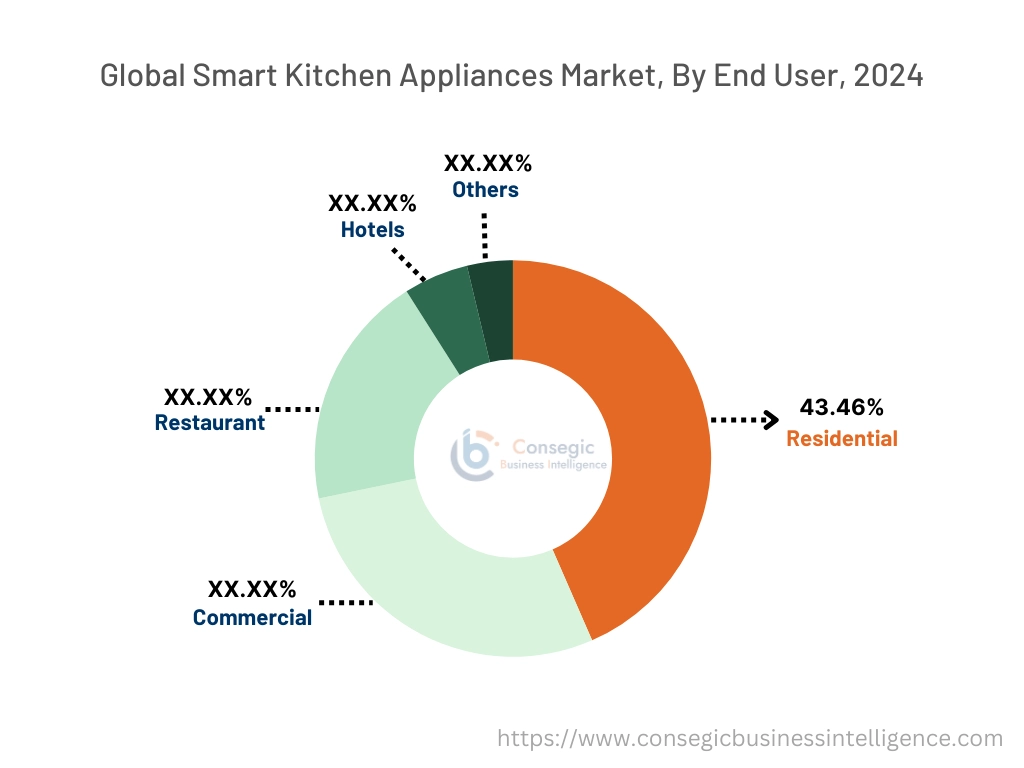
Regional Analysis:
The regions covered are North America, Europe, Asia Pacific, the Middle East and Africa, and Latin America.

Asia Pacific smart kitchen appliances market expansion is estimated to reach over USD 14.73 billion by 2032 from a value of USD 5.07 billion in 2024 and is projected to grow by USD 5.70 billion in 2025. Out of this, the China market accounted for the maximum revenue split of 32.05%. The regional growth can be attributed to the rapid urbanization, increasing disposable incomes, and evolving lifestyle preferences. Countries in the region are witnessing a surge in need for built-in kitchen appliances, driven by urbanization trends and the influence of Western lifestyles. Moreover, government initiatives promoting sustainable housing and energy-efficient appliances further boost market growth in the region. As urban populations continue to expand and living standards improve, the adoption of built-in kitchen appliances is expected to rise. These factors would further drive the regional smart kitchen appliances market during the forecast period.
- For instance, in May 2023, LG Electronics launched InstaView refrigerator with MoodUP in Australia. This refrigerator offers extensive personalization, allowing users to select from a palette of 190,000 colors for its doors through integrated LED panels. It also features a transparent InstaView door for easy viewing of contents and built-in Bluetooth speakers for entertainment.
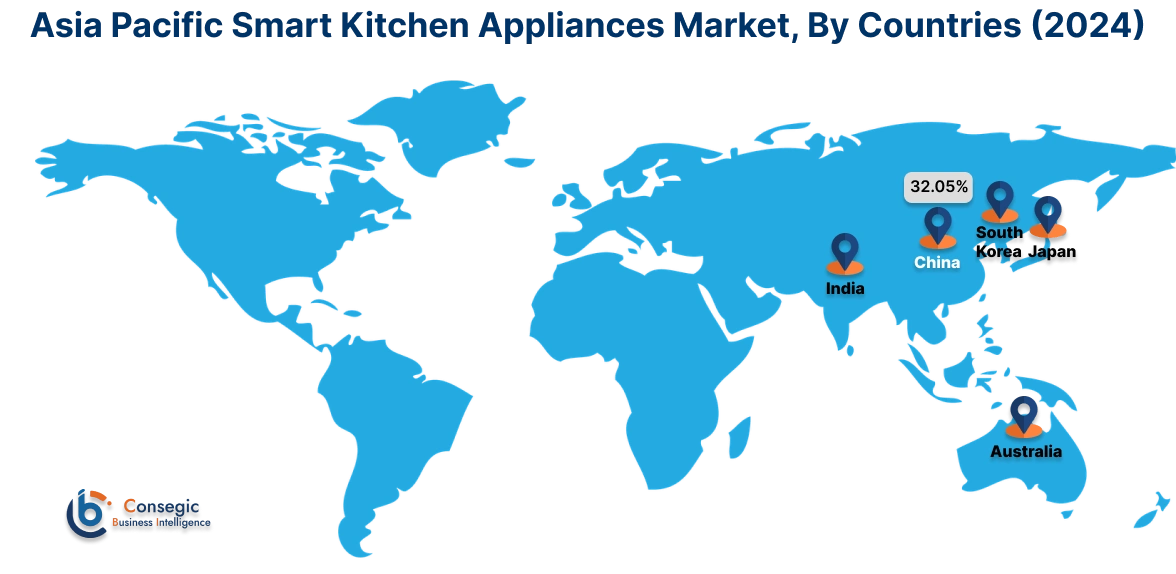
North America market is estimated to reach over USD 19.53 billion by 2032 from a value of USD 6.86 billion in 2024 and is projected to grow by USD 7.70 billion in 2025. The growing adoption of smart appliances to reduce effort and time required for the cooking has become a trend in the region. Further, the consumers in the region have experienced extended work hours, and this demanding work culture significantly shapes their daily lives. Consequently, there has been a noticeable rise in the use of smart home appliances to help manage household tasks and save time. These factors would further drive the regional market.
- For instance, in February 2024, Whirlpool announced the partnership with BORA, to introduce downdraft cooktop technology in North America. Downdraft systems provide kitchen ventilation without requiring a traditional range hood mounted above the cooking surface.
According to the analysis, the smart kitchen appliances industry in Europe is projected to witness significant development during the forecast period. As awareness of energy efficiency and sustainability continues to rise, European consumers are showing a preference for high-quality kitchen appliances that align with these values. Built-in refrigerators and dishwashers are particularly popular among European consumers, reflecting their emphasis on efficient space utilization and eco-friendly features.
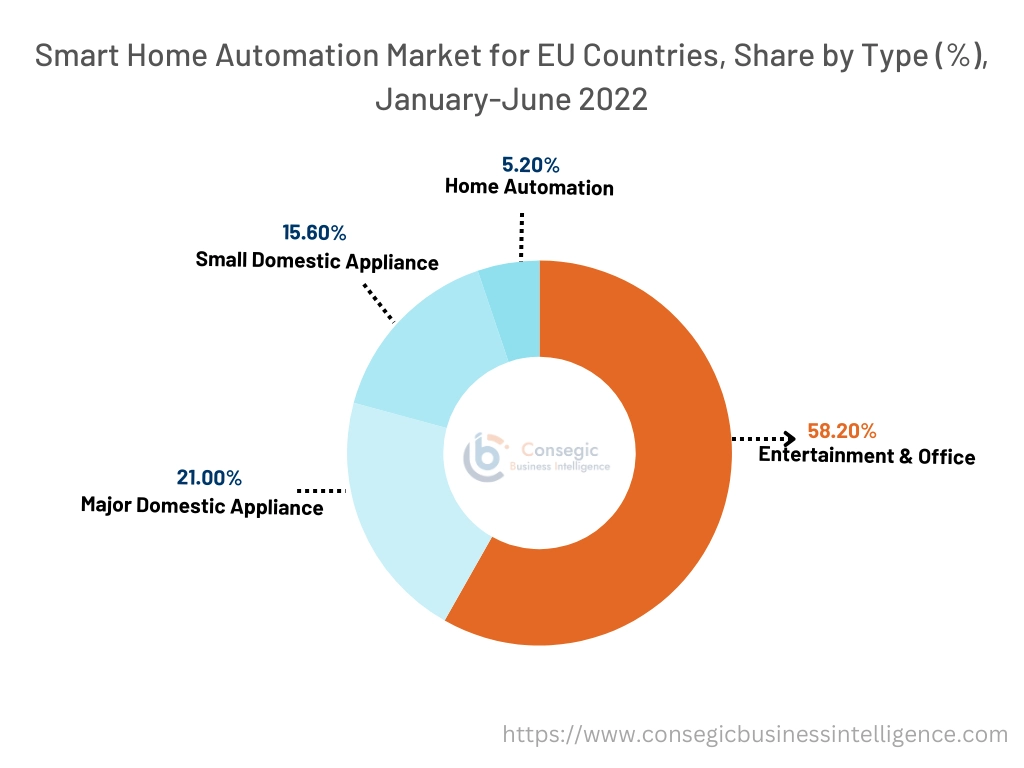
Additionally, Latin America presents an emerging market prospects for smart kitchen products, characterized by growing urbanization, changing consumer lifestyles, and increasing need for convenience-driven appliances. Further, in the Middle East and Africa, smart kitchen applications cater to a diverse range of consumer preferences and economic conditions across various countries. While luxury and innovation drive demand in affluent markets such as the Gulf Cooperation Council (GCC) countries, affordability, durability, and reliability are key considerations in emerging markets across Africa.
Top Key Players and Market Share Insights:
The global smart kitchen appliances market is highly competitive with major players providing products to the national and international markets. Key players are adopting several strategies in research and development (R&D), product innovation, and end-user launches to hold a strong position in the market. Key players in the smart kitchen appliances industry include-
- Breville (Australia)
- Siemens (Germany)
- Dongbu Daewoo Electronics (China)
- Electrolux AB (Sweden)
- Haier Group (China)
- LG Electronics (South Korea)
- Miele & Cie. KG (Germany)
- Panasonic Corporation (Japan)
- Samsung Electronics Co., Ltd. (South Korea)
- Whirlpool Corporation (U.S.)
Recent Industry Developments :
Product Launch:
- In February 2024, Samsung announced the launch of its new energy-saving products, notably the bespoke AI slide-in induction range. The company has also integrated features within their SmartThings energy platform to allow users to monitor and manage their home's energy consumption.
Smart Kitchen Appliances Market Report Insights :
| Report Attributes | Report Details |
| Study Timeline | 2019-2032 |
| Market Size in 2032 | USD 55.87 Billion |
| CAGR (2025-2032) | 15.3% |
| By Type |
|
| By Connectivity |
|
| By Distribution Channel |
|
| By End-User |
|
| By Region |
|
| Key Players |
|
| North America | U.S. Canada Mexico |
| Europe | U.K. Germany France Spain Italy Russia Benelux Rest of Europe |
| APAC | China South Korea Japan India Australia ASEAN Rest of Asia-Pacific |
| Middle East and Africa | GCC Turkey South Africa Rest of MEA |
| LATAM | Brazil Argentina Chile Rest of LATAM |
| Report Coverage |
|
Key Questions Answered in the Report
How big is the Smart Kitchen Appliances Market? +
Smart Kitchen Appliances market size is estimated to reach over USD 55.87 Billion by 2032 from a value of USD 19.88 Billion in 2024 and is projected to grow by USD 22.28 Billion in 2025, growing at a CAGR of 15.3% from 2025 to 2032.
Which is the fastest-growing region in the Smart Kitchen Appliances Market? +
Asia-Pacific is the region experiencing the most rapid growth in the market.
What specific segmentation details are covered in the Smart Kitchen Appliances report? +
The smart kitchen appliances report includes specific segmentation details for type, connectivity, distribution channel, end user, and region.
Who are the major players in the Smart Kitchen Appliances Market? +
The key participants in the market are Breville (Australia), Siemens (Germany), Dongbu Daewoo Electronics (China), Electrolux AB (Sweden), Haier Group (China), LG Electronics (South Korea), Miele & Cie. KG (Germany), Panasonic Corporation (Japan), Samsung Electronics Co., Ltd. (South Korea), Whirlpool Corporation (U.S.), and others.
